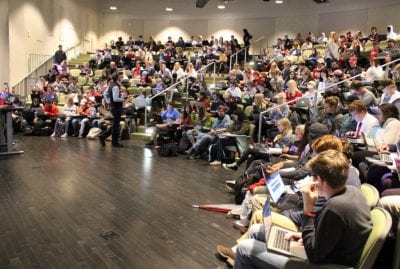Have you thought about incorporating more video in your classroom? Have you thought about exploring a flipped or blended class? Matt Gerner led a workshop on the flipped classroom and creating a video database that could be used with a course.
Matt Gerner, instructor in the Chemistry and Biochemistry department at the University of Arkansas, gave a presentation on video-enhanced instruction for the flipped or blended classroom for the “TIPS for Teaching with Technology” Workshop series.
Gerner structured his workshop to model the flipped classroom. Before participants arrived to the workshop, Gerner asked them to watch this short video on blended/flipped classrooms. He then had participants use the various forms of technology that he uses to enhance the flipped classroom experience.
The workshop was recorded and the two sessions are viewable below.
What is a Flipped/Blended Classroom?
Gerner first defined what he meant by a flipped/blended classroom and how he uses this method. Before class the students must do the following:
- The students watch a video at home and take notes. He uses lecture videos or example problem videos. Students need to take good notes and prepare in order to do well in class the next day.
- Read the assigned reading from the text. The reading supports and relates to the video the students are to watch.
- Complete a “BC” (before class) assignment. This assignment checks for comprehension and understanding of the materials.
For all of these assignments, clear learning objectives are stated for the students on the schedule and students have a clear understanding of what their responsibilities and objectives are for the day.
Because of the BC work that students complete, Gerner knows where the students succeeded and where they struggled. When students get to class Gerner then reinforces the material that students need assistance with and does not need to cover material where students show a proficiency. In-class activities include:
- In-class quizzes over the reading material. Gerner utilizes a student response system to get real-time feedback on what students know and do not know. The quizzes are timed so students who did not complete the reading, watch the videos, or do the BC assignment will likely not have time to look up the correct answer to the questions. This give incentive to students to do the work ahead of time or quickly fall behind. These quizzes are worth a significant amount of their grade, which adds further incentive for completing the work ahead of time.
- Harder practice problems and content is worked through together to help students with comprehension.
- Harder practice problems are also worked through in groups so that students are practicing on their own but also have the support of their colleagues. This course has upwards of 475 students and the group work is still successful. This is a good way to build community in a large lecture section.
- In some cases, the students struggle with the material so Gerner comes prepared to lecture on any and all of the topics covered in class.
- Students then complete an AC (after class) assignment to test their comprehension.
What are some benefits to a flipped/blended classroom?
Gerner noted many different benefits to this pedagogical method.
- students preview the material before class
- instructors do not need to cover every topic in class — if students are proficient, instructors can move on
- peer-to-peer interactions are increased
- students learn better study habits
- students gain skills for independent learning
- there is reusable course material (videos and assignments)
- allows students to review material that they do not understand by rewatching videos
What are some drawbacks to a flipped/blended classroom?
- requires more initial preparation to create videos
- requires instructor to be prepared to lecture on a wide range of topics if students either do not prepare or do not understand material
- classroom spaces are often not conducive to this style of instruction
- requires you to sell students on the benefits of this sort of instruction — it is a shift from what they are used to
Some advice for creating effective videos for the flipped/blended classroom…
- keep the videos short and simple
- consider ways to use the videos for years to come
- use voice-over PowerPoint – if there is video of you, you can date the video pretty quickly
- do not use jokes or pop culture references – if a student watches a video over and over, the joke loses its effect and becomes annoying
- speak clearly and use a script! If you rely on a script you have fewer filler words and “ums” and it makes the process move more smoothly
- ask for help! If you need assistance with creating or editing video, email tips@uark.edu or stop by the TIPS Center in MULN 289 to visit the tips team.
For more information on Matt Gerner’s teaching methods, the presentation can be downloaded and viewed as a PDF: Using Video in the Flipped/Blended Classroom or you can email him at mgerner@uark.edu
You can also view the session recordings here:
This content was developed from a presentation by which was sponsored by TIPS and The Wally Cordes Teaching and Faculty Support Center (TFSC) at the University of Arkansas.


